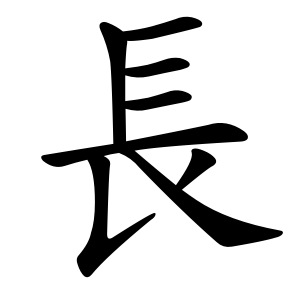長
- long;
- leader, chief, master, person in authority;
- adult;
- to grow;
It carries meanings related to length, growth, seniority, and leadership.
Etymology
Its origin is a pictograph representing an old person with long hair leaning on a cane. It inspired by ancient people who did not cut their hair, thus having long hair. Over time, the meaning expanded from "aging" to include the temporal sense of "long duration" and spatial sense of "length."
Usage in Korean
In Korean, Japanese, and Minbei Chinese, the pronunciations have merged, but originally this character is a polyphone—its reading changes based on meaning:
When meaning "long," it is read as 直良切 (pronounced cháng in Standard Mandarin, with a level tone).
When meaning "adult," "elder," or "to grow," it is read as 知丈切 (pronounced zhǎng in Standard Mandarin, with a rising tone).
There are many variant forms, such as 仧 and 镸. The form 镸 is an old form of 長 and is sometimes used as its radical in variant forms.
Traces of this form remain in characters like 套 and 肆. Another old form, 𠔊, exists but should not be confused with the character 兵 (soldier).
Alternative forms
Words that derived from 長
- 가장(家長)–head of a household
- 곰장어(곰長魚)–sea eel
- 공장장(工場長)–factory manager
- 뱀장어(뱀長魚)–eel
- 병장(兵長)–sergeant
- 성장(成長)–growth; development
- 성장기(成長期)–growth period; time for full growth
- 성장기간(成長期間)–growing period
- 시장(市長)–mayor
- 신장(身長/身丈)–height
- 연장(延長)–extension; prolongation; continuation
- 장(長)–head
- 장고(長考)–long thought
- 장관(長官)–minister
- 장기간(長期間)–long term
- 장단(長短)–length; size; pros and cons
- 장로(長老)–patriarch; elder
- 장성기(長成期)–growth stage
- 장어(長魚)–eel
- 장자(長子)–eldest son
- 장지(長指/將指)–middle finger
- 차장(次長)–deputy manager
- 함장(艦長)–captain; general; commander
- 尸一女 (SMV)
- ⿱⿺ 丄 三 ⿰ 𠄌 ⿺ 乀 丿 (G J K V)
- ⿸⿱⿺ 丄 三 𠄌 ⿺ 乀 丿 (H T)
- ⿱⿰ 丨 三 ⿸ 𰀀 ⿺ 乀 丿 (H T)
